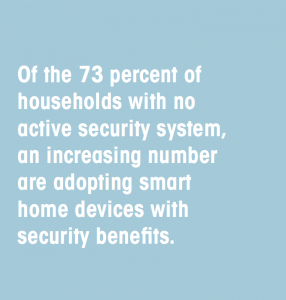By Brad Russell
Recent advances in smart security and safety devices offer consumers new and expanded solutions to help them trade in worry for peace of mind. Companies invested in IoT technologies are leading that effort by producing smart, connected products and services that promise to make the smart home safer than ever.
Home security is the most influential market driver for purchase of these devices to date. Parks Associates research shows more than one-fourth of U.S. broadband households currently own a smart home device of some kind, and half of all security system households report ownership of a smart home device.
Historically, intrusion prevention, detection of safety threats and redress for theft, damage or injury have served as the leading motivators for security device or system ownership. Interestingly, property crimes per 1,000 residents in the U.S. have actually declined for 25 years after a high in 1991. Still, security service providers often experience spikes of interest when neighborhood crime makes homeowners uneasy. Regardless of personal experience, consumer attitudes about the safety and security of property and loved ones understandably drive adoption.
 While consumers are motivated by crime and safety concerns, adoption of a security system can often be triggered by a move to a new home or a change in life stage. More than 60 percent of security system adopters report buying a home or moving from one owned home to another as their adoption trigger. Consequently, security companies have focused marketing efforts on new and existing home purchasers, home builders, contractors and vacation homeowners rather than on renters. Although it is difficult to draw direct cause and effect relationships, the recent uptick in housing stats and home sales has contributed to renewed growth in the home security sector.
While consumers are motivated by crime and safety concerns, adoption of a security system can often be triggered by a move to a new home or a change in life stage. More than 60 percent of security system adopters report buying a home or moving from one owned home to another as their adoption trigger. Consequently, security companies have focused marketing efforts on new and existing home purchasers, home builders, contractors and vacation homeowners rather than on renters. Although it is difficult to draw direct cause and effect relationships, the recent uptick in housing stats and home sales has contributed to renewed growth in the home security sector.
Another factor driving adoption of smart security and safety devices relates to the number of installed legacy security systems that are ripe for an upgrade to new smart security platforms with home control options. Older legacy security systems have controllers that cannot be upgraded to include interactive services or home controls, meaning they do not offer wireless connectivity, remote access and control, or the attachment of smart home devices. Owners of these legacy security systems and subscribers to their related monitoring services are prime prospects for upgrades to more feature-rich interactive security systems with home controls. Those that upgrade often add smart devices in the process, especially because security companies incentivize upgrades by bundling popular smart devices with their offers.
According to Vivint, 80 percent of all current home security households have a legacy system. ADT reported in September 2015 that 75 percent of new customers served by its employee dealers (including upgrades and replacements) are adopting Pulse, its interactive security and home control platform. Meanwhile, Vivint reports that 85 percent of its new customers choose security with a minimum of two smart home devices.

Of the 73 percent of households with no active security system, an increasing number are adopting smart home devices with security benefits, such as smart smoke detectors, water leak detectors and networked cameras that can be integrated with a home control system or operate as standalone devices. Increasing adoption of these self-installable security devices is expanding the market beyond professionally monitored households by approximately 10 percent. It remains to be seen if self-installable and self-monitored devices will evolve into demand for more professional services in the future or if self-monitored devices are adequate for consumers.
The entry of broadband providers and utilities into the professional security space increases competition in the residential security ecosystem. AT&T Digital Life and Comcast Xfinity Secure entered the market in 2013 with monitored security offerings with smart home options. Both companies continue to expand their list of device partners as they seek to capitalize on their substantial subscriber bases.
Additionally, Lowe’s is making its own play with a portfolio of interoperable devices for the Lowe’s Iris platform. Tech giants — Amazon, Apple, Google and Samsung — have made major moves in developing smart home applications, devices and platforms that include smart security and safety devices. Finally, device makers such as Nest, August and Ring have brought to market innovative smart security devices that are generating consumer buzz. For many consumers, standalone devices with clear use cases will be the entry point to the smart home. These entries have created an increasingly complex residential security ecosystem that offers providers both competition and opportunities for collaboration.
In summary, the evolution of IoT products, including key advancements, will continue to drive adoption of smart security devices.
This story originally appeared on IoT Agenda.
Brad Russell is Research Director, Connected Home for Parks Associates. Brad explores leading-edge issues in connected consumer electronics, smart home devices and platforms, IoT data privacy and security, and data-driven applications for Parks Associates, a leading market research and consulting firm.



